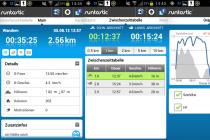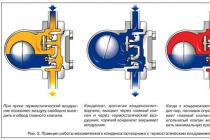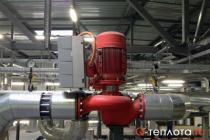Pumps- devices for pressure movement of mainly liquids with the message of energy to them.
Network pump for heating and ventilation systems. This pump is used to circulate water in the heating network. It is chosen according to the consumption of network water from the calculation of the thermal scheme. Network pumps are installed on the return line of the heating network, where the temperature of the network water does not exceed 70 ° C.

Recirculation (boiler, anti-condensation, anti-condensate) pumps are installed in boiler rooms with hot water boilers for partial supply of hot network water to the pipeline supplying water to the hot water boiler.
In accordance with SNiP I-35-76 (p. 9.23), the installation of recirculation pumps is carried out if the boiler manufacturers require a constant water temperature at the inlet or outlet of the boiler. As a rule, it is necessary to provide common recirculation pumps for all boilers. The number of pumps must be at least two. The performance of the recirculation pump is determined from the balance equation of the mixing flows of network water in the return line and hot water at the outlet of the hot water boiler. The regulation of the temperature of the water entering the boiler and the temperature of the water supplied to consumers is carried out as follows. The amount of water supplied by the recirculation pump is adjusted so as to obtain the required water temperature at the inlet to the boiler. However, at the same time, the water temperature at the outlet of the boiler may be higher than the temperature required by consumers. To maintain the desired temperature of the water supplied to consumers, part of the water from the return line is directed through the jumper to the direct line. The amount of water taken from the return line to the direct line is regulated by the network water temperature controller.

Feed pump. Designed to replenish water leakage from the heating system, the amount of water required to cover the leakage is determined in the calculation of the thermal scheme. The performance of make-up pumps is chosen to be equal to twice the amount of water received to make up for possible emergency make-up.
The required pressure of the make-up pumps is determined by the water pressure in the return line and the resistance of pipelines and fittings on the make-up line, the number of make-up pumps must be at least 2, one of which is standby.

DHW circulation pump. Serves to supply the required flow and ensure the required pressure of hot water at the consumer. It is chosen according to the flow of hot water and the required pressure.

Raw water pump. Serves to ensure the required pressure of raw water before the cold water treatment and the supply of chemical. purified water to the deaerator, as well as raw water supply to the hot water tank.
Random materials:
Reading 5 min.
For work in boiler rooms, network pumps are often used. Such products perform the function of pumping hot water in the heat network system. The temperature of the network water, which the installed unit is able to drive through the pipes, reaches +180 degrees.
At the same time, the device and design of network pumps is relatively simple, and at the same time, the devices show a high level of performance along with reliability.
Scope and characteristics
Characteristic features of network pumping devices are ease of installation and unpretentiousness in maintenance. Materials such as high-quality steel and gray cast iron, from which such equipment is made, contribute to an increase in the safety margin and durability of the pump. The technical characteristics of network pumps allow them to work with mostly clean water, which should not contain solid parts with a diameter of more than 0.2 mm, as well as more than 5 mg/l of mechanical impurities.
Most often, network pumping devices are used to create water circulation in heating networks, as well as to service a boiler (heating) network installation. Such units are manufactured both with one gear and in a 2-stage version. The drive operates due to electric power units (motors). They look like horizontal pumps.
The units also include in their device:
- case with a horizontal connector;
- impeller with double-sided water inlet;
- bearings, shaft and end seals;
- chambers for end seals and flanges for mounting bearings installed in the housing;
- rolling bearings that serve as a support for the rotor;
- roller or ball bearing for drive;
- bearing for radial axis.
The average water supply of devices for boiler rooms is 450-500 cubic meters per hour, the pressure is in the region of 50-70 m, and such a parameter as inlet pressure varies within 16 kilograms per square centimeter. Pumps, the purpose of which is to circulate hot water in small heating systems, have lower power and performance indicators, but they also cost an order of magnitude cheaper.
The scope of network products is not limited to heating systems, in particular, boiler rooms. This equipment is successfully used for supplying fuel and lubricants to bases, warehouses and industrial enterprises, for pumping reagents into water treatment plants, as well as in water treatment systems designed to pump water into water supply systems when the pressure level in the pipes drops. At the same time, the use of such equipment is also found in the cleaning of tanks, as well as storage facilities for a substance such as fuel oil.
What pumps are used for boiler rooms?
Network pumps for boiler rooms are most often centrifugal, equipped with an electric motor. By type, they can be divided into:, network, make-up, intended for raw water. You can also find such a type of pumps as nutrient.
In boiler water supply systems, it is accepted install several devices at once with the same characteristics. The pumps are connected in parallel, while one of them is the main one, and the second is a backup and starts as needed when the first one fails. However, the operation of two devices at once is also possible. In this case, the water pressure in the pipes remains the same as during the operation of one installation, but the water supply increases, the level of which becomes equal to the sum of the supply of each of the devices.

For boiler rooms, the best option would be to install a centrifugal 1-stage pump of the KM type, a 1-stage D-type unit with 2-sided suction, or a TsNSG type. In addition, many professionals recommend installing condensate-type boiler installations in a KS-type boiler plant. In this case, the final choice depends on the specific requirements of the buyer, which, as a rule, are determined by the operating conditions of the future equipment.
Device selection and calculation of the required pressure
Pumps for boiler rooms are selected strictly based on the requirements of the heating system, or rather, from the required pressure. To understand what pressure is needed for the optimal operation of your system, you can refer to the formula created for this purpose.
The calculation of the pressure level, which is necessary for the proper functioning of the heating system, can be calculated using the following formula: H=(Lsum*Rsp+r)/(Pt*g).
The formula at first glance does not look the most simple, however, when studying each value, it will not be difficult to calculate the required pressure. The symbols in the formula, by which you can calculate the required pressure, mean:

- H is the required head pressure in meters of water column;
- Lsum is the total length of the circuits, taking into account the return and supply pipes. If you use a warm floor, you need to take into account the length of the pipes laid under the floor in the calculation;
- Rud is the specific resistance level of the pipes of the system. Given the margin, they take 150 Pa per 1 linear meter;
- r is the total resistance value of the system pipeline;
- Pt is the specific density of the heat carrier;
- G is a constant, which is equal to 9.8 meters per square centimeter, or a unit of gravitational acceleration.
Often there is a difficulty in calculating the total resistance of system elements. However, in this case, it is possible to simplify the general formula by replacing the coefficient k, which is a correction factor, instead of this sum. So, the correction factor of the system in which any thermostats are installed will be equal to 1.7.
For a conventional system with standard fittings and taps that do not have elements for thermostatic adjustment, the correction factor is 1.3. The system, which has many branches and shut-off and control valves with high saturation, has this coefficient at the level of 2.2. The calculation according to the final formula, in the case of a correction factor, will look like this: H=(Lsum*Rsp*k)/(Pt*g).
After calculating according to this formula, you can understand what parameters and characteristics the pump that you want to purchase has. We emphasize that it is recommended to choose a pump for boiler rooms one whose power will not exceed the pressure necessary to create the necessary pressure. Buying a pump with more power than needed to provide the desired pressure, you simply waste your money.
Installation of a boiler room of a private house (video)
Reading time: 3 min
Large heating systems cannot exist without pipeline systems: air, water, condensate, fuel oil pipelines. Sometimes they have long sections with high hydraulic resistance, which various pumps help to overcome.
Up to two dozen similar units of different functionality, designs and dimensions are installed in a medium-sized boiler house. The network pump for the boiler room has the largest dimensions and performance.
It is installed in the boiler room and serves to pump the main coolant from 1 t/h for small heating areas to several thousand t/h for large metropolitan areas.
The Wilo network pump for the boiler house draws water from the return network pipeline, drives it through the network heating installation (boiler room), where several water-water or steam-water network heaters are compactly located, in which the heating circuit coolant is heated according to the schedule depending on the outside temperature. The heating medium is steam or hot water at the outlet of the boiler.
To overcome all resistances, the German unit must provide a pressure drop of up to 3 atm. Incorrectly selected or installed equipment, as well as violations of the requirements for the operation of heat networks, will cause a malfunction of the operating mode or an emergency stop of the equipment of the heat production system.
Types of boiler room pumps
Network units are among the largest pumping equipment of the boiler room, although they are not the only pumping mechanisms.
There are the following types of pumps used in boiler plants:
- nutritious steam and water;
- make-up;
- raw water;
- network circulation pumps;
- liquid fuel recycling;
- fuel oil;
- condensate.
All units are preliminarily carefully calculated and selected in the relevant sections of the boiler plant project. This is due to the particularly high requirements for the reliability of the equipment used to ensure the production of thermal energy.
The main purpose of all pumps is the circulation and supply of the medium to the distribution point. At the same time, they must work continuously for a long time.
Network pump and its purpose
This unit must pump at the optimum speed and pressure the heating fluid in the supply pipeline according to the temperature schedule of 150-70 C, depending on the outdoor temperature. Their feature is the proximity of the location of the cooling circuit to its seals.

They also differ in their performance and high performance. The parts of the unit, such as the casing and the impeller, are made of a durable cast iron alloy, which ensures the wear resistance of the entire structure.
The reliability of the design development is confirmed by many years of experience in operating units in areas of high temperatures and hydraulic shocks. The circulation unit is unpretentious, it does not need time-consuming maintenance.
They are easily mounted in a heating system, having a simple design and a long guaranteed period of operation. The conditions for selecting a network unit are the working pressure, the maximum temperature of the heated water, the quality of the working environment. They are designed for water with a concentration of mechanical impurities not higher than 5 mg/l.
Feed pump and its purpose
This group of units works only with steam boilers with a pressure of more than 0.7 atm, they serve to fill the boiler with water instead of the amount that went into generating steam and blowing salt water out of the boiler.
This is a very important unit, the efficiency of the boiler depends on its reliability, and if it is not fed with water, then the pipe heating surfaces will overheat, followed by an explosion of the steam generator.
Therefore, the requirements of the Kotlonadzor require the mandatory installation of at least two feed units, and with different movements of the working surface - one with a steam converter, and one with an electric source.
There are also requirements for the minimum performance of devices, each must provide 150% load of simultaneously operating boilers, that is, work with a significant margin.
If, according to the scheme, 3 or more units are installed in the boiler room, the type is chosen so that when the most powerful one leaves, the total performance of the pumps remaining in operation provides 120% of the rated load of the boilers. Electric centrifugal and reciprocating steam pumps are used.
Raw water pump
This group of pumps is used in the chemical water treatment system. Their task is to take the medium from the raw water tank and send water for chemical purification from hardness salts and suspended solids, after processing it enters the chemically treated water tank or deaerator to remove excess oxygen.

Usually these are units of low power and operating pressure, since they operate in a closed circuit of a pipeline system that does not have large hydraulic losses.
Its operation can be carried out by the HVO operator manually, through the "Start" button or by the automation system based on water level sensors in the tank. The selection is made according to the design capacity of the chemical water treatment system, taking into account a 100% reserve.
If the raw water unit fails, the deaerator will not be fed, the reserves of which are usually enough for several hours of operation of the boiler, subsequently the boiler will be stopped by the safety automatics due to the low water level in the deaerator.
condensate
Condensate pumps are used at large thermal facilities, for example, at thermal power plants, where they are used to pump condensate obtained from exhaust steam and supply it through a group of low-pressure heaters to deaerators, and in steam heating circuits of industrial enterprises, when it is necessary to pump exhaust condensate from consumers to the boiler room.
They are distinguished by low operating pressures, as they are limited by the pressure of the medium in the condensate collectors, therefore, when they are designed, they require high anti-cavitation protection, since even a slight decrease in the pressure of the medium at the time of pumping causes it to boil.
Condensate pumps in the circuits are installed with a reserve of 2 to 4 units. The performance is calculated according to the maximum volume of condensate, and the pressure must be sufficient to extinguish the resistance in the system between the condensate pipeline and the deaerator, taking into account the hydrostatic head due to the difference in the levels of the equipment installation sites: condensate collector- the lower setting is at the “zero” mark, the deaerator is the upper one, approximately on the second or third floor of the boiler room building.
make-up pump
This device serves the heating plant in the thermal scheme of the boiler house and is designed to replenish water leaks from the main network.

Its performance is calculated according to the volume of the heat supply network, based on the norms of certain SNIP and is performed when calculating the thermal scheme. In this case, the resulting performance is equal to a double margin for standard leakages in the network, which are 0.75% of the total volume of water in the system.
The number of units must be at least two, equal to the capacity, one of which must be redundant. The pumps are installed on the return line, so their working pressure must exceed the pressure in it by at least 50%. The control is performed manually by the operators of the boiler house, according to the pressure drop in the return network water and automatically when the low pressure sensor in the network is triggered.
How pumps are controlled
In modern boiler houses, pump control refers to the functions of integrated automation. However, this does not exclude, in emergency situations, the possibility of manual control performed by operating personnel.
In all directions of movement of the process fluid, there is a redundant equipment, the same requirement is made for the presence of a backup power supply.

For large thermal circuits, this should be an independent source of electricity, for example, from another transformer substation, and for small and medium power devices, there should be autonomous power supplies, for example, diesel generators.
To reduce emergency situations, especially in heating networks due to water hammer, a system of frequency converters (FC) has recently been used, which contributes to:
- energy savings up to 20%;
- reduction of water consumption, due to the reduction of leaks up to 5%;
- reducing the cost of repairing heating systems, since due to a change in frequency, the service life of a group of pumps increases 1.5 times;
- reduction of fuel consumption for heating network water.
How to choose a pump: calculation
To select the unit, the performance, the pumping medium are taken into account and the required pressure is calculated. It shows the difference between the difference in the medium when the unit is turned off and on, measured in m.w.s., it is calculated by the formula:
H=(L xR xZ)/(ρ xg),
L is the total length of the pipeline in two directions, m.
R - losses in pipes per 1 m are 150 Pa;
ρ – specific water density 1000.0 kg/m3;
g - 9.80 m/s2.
Z is the correction factor.
Circulating network pumps for installation in a boiler room or heating have been used by many owners of private households and summer cottages for a long time. Steam piston pumps allow you to provide heat to the premises at any time of the year, since they do not depend on utility networks.
In this article, we will tell you what the operation of such devices for thermal boilers is, what are the features of use, and how to correctly calculate the power of pressure, heat and pipeline resistance when buying equipment.
1 How to choose a network pump?
The feed pump for water circulation and thermal boilers is selected based on the following nuances:
- the amount of heat required to heat the building;
- calculation of the thermal insulation index of walls;
- climatic conditions of the region where the consumer lives;
- whether there are window frames in the building and how many of them;
- selection is also carried out taking into account the structure of the surface of the ceiling and floor.
In order to correctly calculate the device for water circulation, the choice of the unit for thermal boilers is carried out with the choice of coolant. The selection of this element includes an analysis of the properties of viscosity, heat transfer, and heat capacity. In order for the operation of thermal boilers to be the most efficient and balanced, network pumps are selected taking into account these parameters.
1.1 Features of use
The calculation and selection of a device for water circulation should be carried out taking into account all aspects. For example, if you buy a SE 2500 60 pump, and the power of your system is less, then the circulation unit will consume an order of magnitude more electricity. In addition, the SE 2500 60 pump, when operating in a low-power system, will provoke the appearance of noise in the pipes, which indicates that the feed pump was selected incorrectly.

However, the noise in the pipes is not always the result of incorrect operation of the water circulation device for the boiler room. Often, noise occurs when an air lock has formed in the batteries. The process of removing air pockets is carried out using specialized valves, but this must be done before you start heating the house.
In the event that there is no air in the pipes, and the system as a whole is running, the feed pump should work for some time, after which the process of removing the air lock is repeated again. Then the SE 800 pump or another brand should be adjusted again, however, most companies produce circulation devices with an automatic adjustment function. When the air lock is completely removed and the device is adjusted, the boiler room will be ready for full operation.
If your circulation steam pump is unregulated, then the first start-up of water should be made at the smallest pressure. Regulated SE pumps for thermal boilers only need to be configured in such a way that the release function is enabled - then the device will independently regulate the pressure. Modern units for water circulation are equipped with a metal case and ceramic bearings. Thanks to this, the operation of the unit will be almost silent.
1.2 Power calculation
The calculation and selection of the power that SE pumps have is made from an analysis of the need for heat in a house or room. The calculation of this indicator is carried out taking into account the coldest temperatures of the climatic zone in which the consumer lives.

Below we will tell you how to correctly determine the necessary indicators so that the pressure during operation of the device is the most optimal and can warm the whole house.
1.3 Heat
Heat calculation is the first thing to do when choosing PE feed pumps. First of all, in order for the operation of thermal boilers to be more efficient, it is necessary to calculate the area of \u200b\u200bthe building that it will heat. In accordance with international standards, the calculation is made as follows:
- For one square meter of a house in which two apartments are located, a FE 800 100 W energy device or from another manufacturer is required.
- For multi-storey buildings, you can purchase a SE 1250 70 circulation pump, a SE 500 70 apparatus, or any other circulation pump in which the power is 70 watts.
If the house was built in violation of the norms, then when calculating the power, the part of the building with an increased level of heat consumption should be used. In the event that your house or building is equipped with additional thermal insulation, then for thermal boilers of these systems, you can use drives with a consumption of 30 to 50 W / m². In the countries of the post-Soviet space, utilities are engaged in the calculation according to the following principle:
- Small buildings (1-2 floors) consume about 170 W / m² if the air temperature is 25 degrees below zero. If the temperature drops to -30, then this figure increases to 177 W / m².
- If the building is multi-storey, then the heat boiler drives will consume about 97-102 W / m².
Now, as for the choice of performance, which the drives should have.

It can be pump SE 1250 70, apparatus SE 500 70 or any other, performance calculation is carried out according to the formula G=Q/(1.16xDT), where:
- 16 is an indicator of the specific heat capacity of the liquid.
- DT is the temperature difference in the supply and return pipelines. Usually this figure is about 20 degrees. In low-temperature systems, it is reduced to 10%, and if the building is equipped with an underfloor heating system, then only 5 degrees.
2 Pressure calculation
In addition to the above parameter, the SE 1250 140 pump or any other drive must create the necessary pressure, that is, pressure. The pressure indicator must be such that the liquid can circulate through the system without problems. When designing a new building, it will be difficult to calculate the head pressure so that the result is accurate. As a rule, all information is indicated in the service book for the SE 500 pump or another brand. How to calculate the head using the formula H=(RxL+Z)/p*g:
- R is the resistance index in a flat pipe;
- L is the total length of the pipeline;
- Z is the reinforcement resistance index;
- p is the density;
- g is the free fall acceleration index.
Please note that this formula for calculating the pressure is relevant only for new heating systems.
2.1 Pipeline resistance
If you decide to purchase a SE 1250 140 pump or a SE 800 100 device, or from another manufacturer, then you should not forget about the resistance of the pipeline. In practice, experts have found that this indicator varies in the region of 100-150 Pa/m.

Then the pressure that the pump SE 1250 140 or any other should have should be from 0.01 to 0.015 m per meter of pipe.
Also, experts assure that when water passes through reinforced sections, about 30% of the entire pressure force is lost. If the system is additionally equipped with a thermostatic expansion valve, then this figure can be increased by 70%.
When you have calculated all the necessary parameters, you need to decide on the budget and select a device that matches the characteristics obtained. If there is no such unit, then the characteristics should be at least approximately the same. Remember that the numbers obtained are indicators of the operation of the device at maximum loads.
But since the need to use devices with heavy loads is minimal and can only occur a few times a year, if you need to choose a more powerful or less powerful unit, experts recommend opting for a less powerful one. In practice, this does not affect the operation of the heating system as a whole.
2.2 Etaline model - dismantling, installation, fault diagnosis (video)
Description
Applications
Pumping units of industrial boiler houses perform the following functions:
- carry out the circulation of the coolant in the heating circuits of the boiler;
- the heating network is fed with specially prepared water that has undergone chemical water treatment.
Features and design
Pumps that create the necessary water pressure in the heating networks of boiler houses and thermal stations are called network pumps. In fact, these are circulation pumps that ensure the movement of the coolant in the main heating circuits. Network pumps are installed in the return pipelines, immediately before entering the boiler. This arrangement provides the most favorable operating conditions for the pumping units, since the temperature of the network water at this point is the lowest.
Network pumps are equipped with capacity control systems that allow flexible control of the operating mode of the heating heating network. Usually, control systems for network pumping units are part of the automated process control system for a boiler house. Automation tools allow you to maintain optimal parameters of the heating network in case of changing weather conditions, consumed heat load and other factors. Regulation is carried out by changing the power of boilers and the performance of network pumping units.
Advantages
The use of pumps for industrial boiler houses has the following advantages:
- ensuring the operability of the heating system when gravity circulation of the coolant is not possible;
- the possibility of regulating the heat transfer of the network by changing the performance of network pumping units;
- maintaining the nominal parameters of the network.














